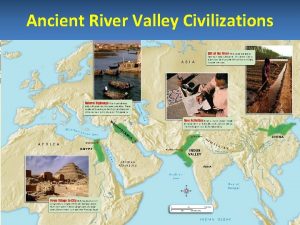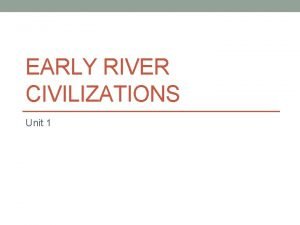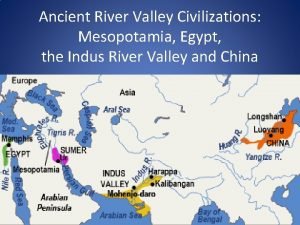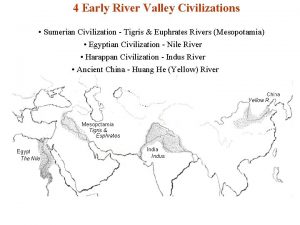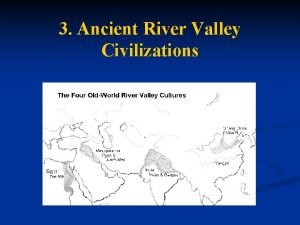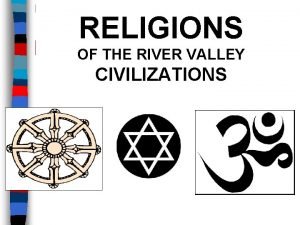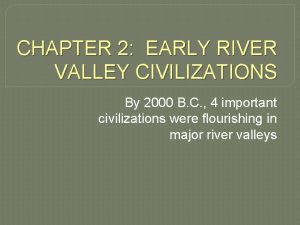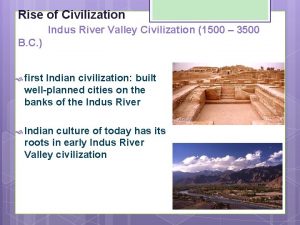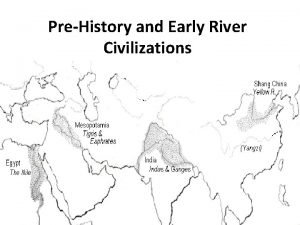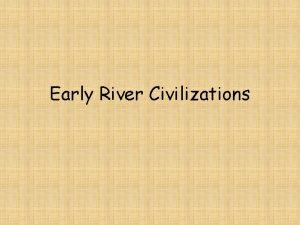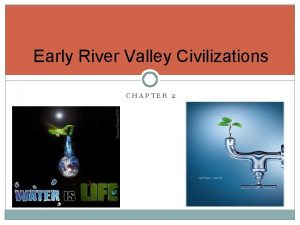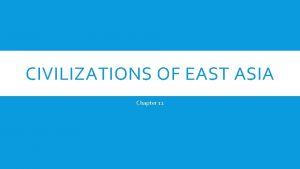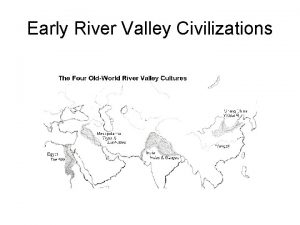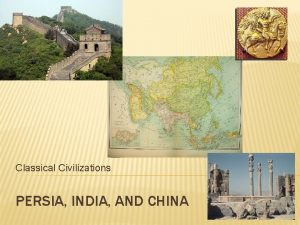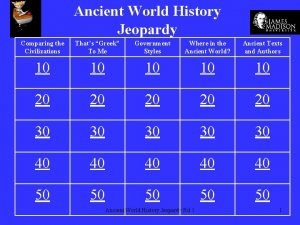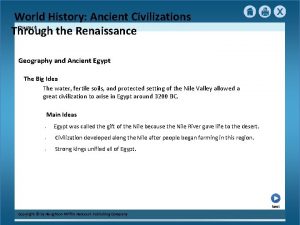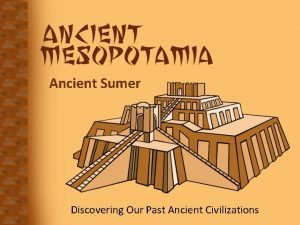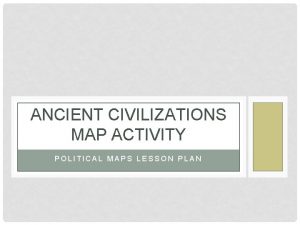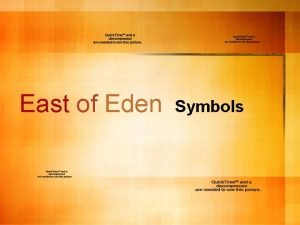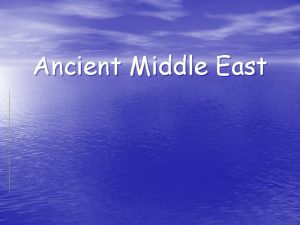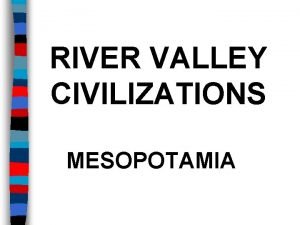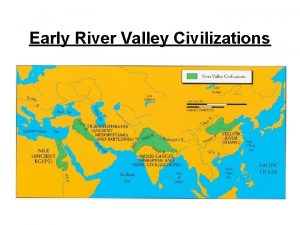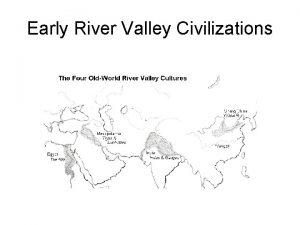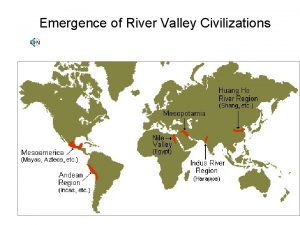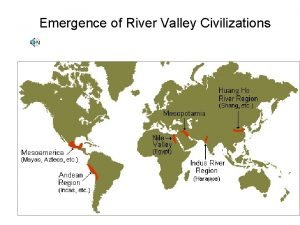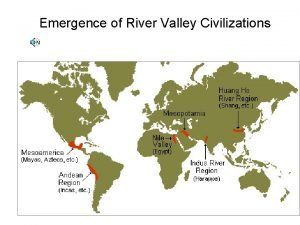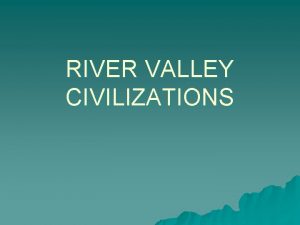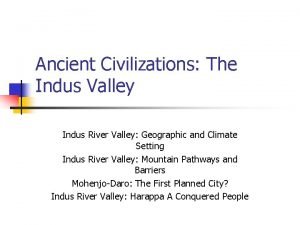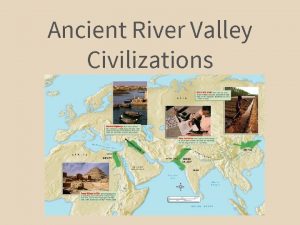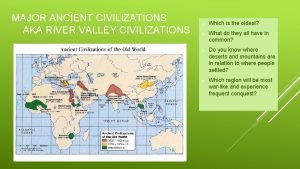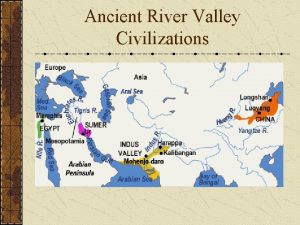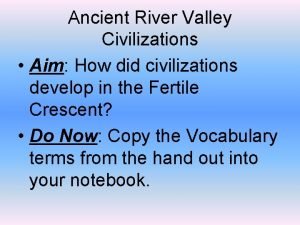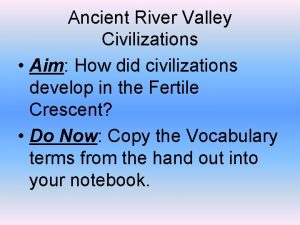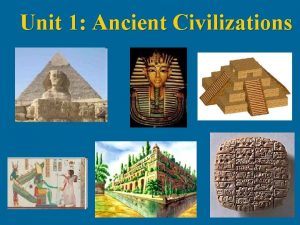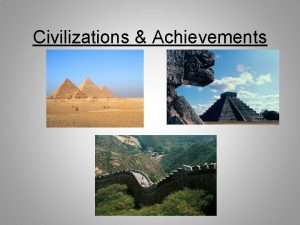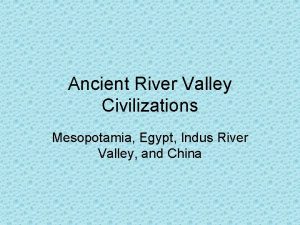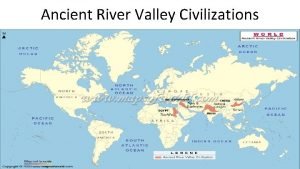Ancient Middle East River Valley Civilizations Civilizations developed


























- Slides: 26

Ancient Middle East

River Valley Civilizations • Civilizations developed in river valleys because they provided: – Resources (water, fertile soil) – Transportation to support trade – Sustainable food supply


Fertile Crescent Mediterranean to Persian Gulf • Mesopotamia • - Means: “Land between the rivers” Tigris and Euphrates flow through region sometimes these rivers flood and leave behind silt after water goes down § Silt: rich soil

Sumerians Civilization – 3000 B. C. • What is a city-state? A city and surrounding lands with it’s own ruler Much like a modern day country Examples: Eridu, Uruk, Umma, Ur

Priests • Controlled • • government Acted as gobetween with gods Managed irrigation system – demanded crops as taxes

Ziggurat • • • Religious center City Hall “Mountain of God” Center of all cities Conduct rituals at the top of the ziggurat

Ziggurat at Ur

Monarchs • Time of war a • strong man took over Gave back power after war

Monarchs to Dynasty • Military leaders • became full rulers Rulers passed on power to sons – This establishes a dynasty

Cultural Diffusion • Sumerian food • surplus leads to long distance trade This leads to the spread of ideas and products from one culture to another

Polytheism and Sumerian Gods • Belief in many Gods • • • - almost 3000 god & goddesses - controlled forces of nature Had human qualities Immortal and all powerful Most powerful god was Enlil clouds and air

Sumerian and their Gods • Lowest of all Gods were Udugs – Cause disease and misfortune • Humans were god’s servants – Offered sacrifices to keep Gods happy

Innovations • Wheel, Plow, Sail • Cuneiform: earliest • • form of writing - 2300 B. C. - Gilgamesh: world’s oldest epic poem astronomy, chemistry, medicine Architectural innovations - arches, columns, ziggurat


Cuneiform Tablet

First Mesopotamian Empires • Sargon conquered most • • of the Fertile Crescent - He was an Akkadian Adopted Sumerian culture Established first empire – Brings together people under 1 ruler

Babylonian Empire • Amorites conquer • Sumerians in 2000 B. C. Hammurabi’s Code - 1792 -1750 B. C. - collection of 282 laws - Applied to everyone - Eye for an eye - Patriarchal: dominated by men, women had few rights

Hittites (2000 -1200 B. C. ) • Empire in Western Asia (modern day Turkey) Iron weapons and chariots • • First people to make use of iron • Conquered Babylon 1595 B. C. • Borrowed Mesopotamian culture Fell to unknown group described as “Sea Peoples”

Phoenicians 3000 B. C. • Lebanon • Purple dye, glass, lumber • Alphabet; maritime trade • Established colonies for trade • Established Carthage and cities of Byblos, Tyre, Sidon

Israelites 1500 -722 B. C. • Lived to the south of the • Phoenicians MONOTHEISTIC – worshiped ONE god – Practiced Judaism • Hebrew writings – Torah

Abraham • Abandoned polytheism ->Covenant with God • • (Promised Land) Traveled to Canaan 12 sons of Jacob-12 tribes of Israel

Captivity in Egypt and the Exodus • Left Canaan and traveled • • to Egypt Enslaved by Egyptians Moses – Mt. Sinai – Ten Commandments • Exodus-journey out of Egypt – Passover

Kingdom of Israel • Original government divided by tribes and ruled by • • • judges Saul-first king; not well supported by the people David-well-liked; strong military; Jerusalem Solomon-ruled during height; expanded trade; temple in Jerusalem

Decline • Israel divided • • • (Israel and Judah) Fell to the Assyrians (722 B. C. ) Eventually enslaved by Chaldeans (586); known as Babylonian Captivity Diaspora – Jews migrated to other areas of the Mediterranean region

Assyrians 900 B. C. • Nineveh • Conquered Egypt, • • Mesopotamia, E. Asia Minor Powerful military-chariots, foot soldiers, cavalry, iron weapons, terrorism, cruel System of roads; messengers Library Conquered by Chaldeans (612 B. C. )
 River valley civilizations map
River valley civilizations map Civilization ppt template
Civilization ppt template Ancient river valleys map
Ancient river valleys map River valley civilization map
River valley civilization map 4 river valley civilizations
4 river valley civilizations Ancient chinese civilization
Ancient chinese civilization Which cultures believe in reincarnation
Which cultures believe in reincarnation River valley civilizations def
River valley civilizations def Seasonal winds that dominate india's climate
Seasonal winds that dominate india's climate River valley civilizations map
River valley civilizations map River valley civilizations vocabulary
River valley civilizations vocabulary Indus river valley job specialization
Indus river valley job specialization River valley civilizations map
River valley civilizations map Chapter 2 early river valley civilizations
Chapter 2 early river valley civilizations East river valley religion
East river valley religion Laissez faire theory
Laissez faire theory Lesson quiz 11-1 civilizations of east asia
Lesson quiz 11-1 civilizations of east asia 4 river civilizations
4 river civilizations Chapter 9 lesson 1 ancient india
Chapter 9 lesson 1 ancient india What is it
What is it Ancient history jeopardy
Ancient history jeopardy World history ancient civilizations through the renaissance
World history ancient civilizations through the renaissance Discovering our past ancient civilizations
Discovering our past ancient civilizations Ancient civilizations map activity
Ancient civilizations map activity Eden symbol
Eden symbol Antelope valley east kern water agency
Antelope valley east kern water agency Rift valley plate boundary
Rift valley plate boundary

